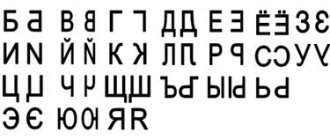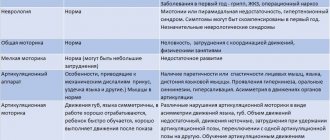Speech therapist
Bratanova
Olga Alexandrovna
30 years of experience
Speech therapist
Make an appointment
Dyslexia is a disorder related to reading skills. Due to problems with certain mental functions that should be involved in the formation of such skills, a child may experience a variety of difficulties when working with text. Most often, it is difficult to recognize individual symbols and signs - as a result, the meaning of words, phrases or sentences is not captured or is distorted.
The problem appears from childhood and with proper correction can be leveled to a level that allows you to live comfortably and study effectively. But if you don’t pay attention to it at an early age, it remains in adulthood, causing a lot of inconvenience. At the same time, it is important to understand that dyslexia does not determine a child’s development in itself - he can effectively perceive information through other channels, for example, good listening comprehension.
History of dyslexia
The concept of “dyslexia” was introduced in 1887 by the German physician and ophthalmologist Rudolf Berlin. Then he worked with a boy who was experiencing difficulties in learning to write and read, despite normal intelligence and physical development. In 1896, the British Medical Journal published an article by another specialist, therapist W. Pringle Morgan, “Congenital Word Blindness,” which described a unique psychological disorder that affects the ability to learn to read. This article presented another case similar to that of Berlin.
In 1925, neurologist Samuel T. Orton began studying this phenomenon. He noticed that reading difficulties have nothing to do with visual impairment, and are most likely caused by asymmetry of the cerebral hemispheres. However, this theory was rejected by many scientists who believed that the main reason for the deviation was problems with visual perception of information. Finally, in the 1970s, a theory emerged that dyslexia is the result of defects in metaphonological or phonological development. It is this theory that has a large number of supporters today.
List of sources
- Kornev A.N. Reading and writing disorders in children. St. Petersburg, “Rech”, 2003. 330 p.
- Maslova O.I. Disorders and correction of cognitive functions of schoolchildren. Pharmaceutical Bulletin. - 2004.- No. 14.- p. 28.
- Chutko L.S., Livinskaya A.M. Specific disorders of speech development in children: Educational and methodological manual. St. Petersburg; 2006.
- Surushkina S.Yu., Yakovenko E.A., Chutko L.S., Didur M.D. Dyslexia as a multi-disability disorder. Journal of Neurology and Psychiatry. S.S. Korsakov. 2020;120(7): 1–7.
- Sadovnikova I.N. Corrective education for schoolchildren with reading and writing disorders. A manual for speech therapists, teachers, psychologists of preschool institutions and schools of various types. - M.: ARKTI, 2005. - 400 p.
Causes of dyslexia
Some of the most reliable methods for studying dyslexia are neuroimaging methods, such as MRI (magnetic resonance imaging), PET (positron emission tomography), etc. With their help, scientists were able to prove that deviations are caused by neurobiological reasons. Thus, in people with dyslexia, the area of the posterior part of the left middle temporal gyrus is less active. In addition, they have differences from the norm in the structure of the brain tissue - in the area of the posterior part of the middle temporal gyrus on the left there are areas of reduced density.
Along with these neurobiological factors that produce the development of dyslexia, experts identify others:
- Predominance of activity in the right hemisphere of the brain
- Imbalance between the hemispheres of the brain
- Traumatic brain injuries
- Severe infections such as meningitis
- Labor disorders: premature placental abruption, fetal asphyxia
- Complications during pregnancy associated with infections (measles, herpes, rubella) or the use of toxic substances (drugs, alcohol, smoking)
Social factors are also considered equally important, for example, excessive teaching loads or pedagogical neglect, dysfunctional environment, lack of communication, isolation syndrome, expressed in complete loss of speech and paralysis (with simultaneous preservation of sensitivity and consciousness). Along with the causes, the manifestations (symptoms) of dyslexia are no less varied.
Symptoms of dyslexia
The manifestations of dyslexia are very diverse, and often depend on the age of the person suffering from this disease. To make it easier to understand, the symptoms are divided into several subgroups. Let's look at them.
The very first symptoms of dyslexia (regardless of age, this category of symptoms is very important, because it indicates that the process of development of the disorder has begun; if you notice five or more of these signs, we recommend not delaying consultation with a specialist):
- Awkward grip of a pen (or other writing instrument)
- Problems with attention and concentration
- Bad memory
- Changes in letter order when composing words
- Changes in letter, syllabic, or number order when writing and reading
- Refusal to read aloud and write essays
- Difficulties in learning the alphabet and multiplication tables
- Difficulties in simple orientation (left-right, top-bottom, etc.)
- Problems following basic instructions
- Difficulties in mastering spelling and reading principles
Symptoms of dyslexia in preschool age:
- Delayed speech development
- Difficulty learning and pronouncing words
- Poor verbal memory (difficulty recalling words, confusion)
- Difficulties in mastering basic writing and reading skills
- Confusion in the arrangement of letters and words
- Problems communicating with peers
Symptoms of dyslexia in primary school age:
- Difficulty recognizing words
- Replacing words that are similar in meaning and sound
- Turning over (inversion) and rearranging (transposition) letters, syllables and words when reading
- Rotating letters when writing
- Confusion in arithmetic signs
- Clumsiness and impulsiveness in behavior
- Difficulty remembering facts
- Impaired motor coordination
- Slow learning of new skills
Symptoms of dyslexia in middle school age:
- Low reading level (compared to peers)
- Refusal to read aloud or write
- Bad memory
- Unreadable handwriting
- Incorrect spelling and pronunciation of words
- Difficulty perceiving body language and facial expressions
- Difficulty communicating with peers
Symptoms of dyslexia in high school age:
- Poorly developed writing skills
- Slow reading and a large number of reading errors
- Errors in pronunciation of words
- Difficulties with perception, retelling, presentation and generalization of information
- Bad memory
- Operation speed is too slow
- Difficulty adapting to any changes
Symptoms of dyslexia in adulthood:
- Difficulties in perceiving written and audio information
- Difficult to understand words pronunciation
- Poor writing skills (dysgraphia) or their complete absence
- Confusion about the sequence of words and numbers
- Absent-mindedness and inattention
- Bad memory
- Difficulty organizing and planning your time
By the way, in order to quickly recognize the development of dyslexia in a child, we recommend watching the video “How to understand that a child has dyslexia.” If you notice pronounced above-mentioned signs in your child, you should immediately contact a specialist who has all the necessary tools for professional diagnosis of the deviation.
Why is this happening?
Experts associate the manifestation of dyslexia with a delay in maturation or damage to certain areas of the brain, provoking the occurrence of MMD - minimal brain dysfunction. In addition, a factor contributing to the appearance of reading problems is a dysfunction of higher nervous activity. In essence, reading is a consistent work of the psyche to:
- visual recognition of letters in the text;
- matching each letter with the corresponding sound;
- combining these sounds into syllables, words and sentences; understanding the meaning of the text read.
Violation of this sequence or any link in the chain of actions leads to the occurrence of dyslexia.
Diagnosis of dyslexia
The first step in diagnosing dyslexia is to visit your pediatrician. Having examined all the signs and made a conclusion about the need for treatment, he will refer the child to a speech therapist, who will carry out the main work with him.
In most cases, speech therapists begin to collect a detailed medical history (all the necessary information about the course of the disease). Most likely, you will need to tell how the pregnancy proceeded, whether there is a genetic predisposition to such ailments, whether the child has congenital diseases, how the child developed in the first years of life.
Having collected all the data, the speech therapist will find out how developed the child’s reading, writing and speech skills are, what are the features of the formation of these skills, how developed the articulation apparatus is and what is the development of motor skills. If the child is already going to school, the doctor will find out what his progress is in literature and the Russian language.
In addition, the specialist may conduct several specialized tests, such as listening, rewriting, and reading aloud. If deviations are detected, the speech therapist will determine the characteristic features of the disease and determine its type.
Types of dyslexia
Despite the striking symptoms of dyslexia, its development does not necessarily imply the presence of all manifestations. Symptoms will always depend on the type of dyslexia. In total, experts identify six types of violations:
- Mnestic dyslexia – difficulty recognizing letters in a spoken word or sound
- Agrammatic dyslexia – underdeveloped speech, errors in grammatical construction (tenses, cases and endings do not agree correctly, for example, “I want to go home”, “gray dog”, etc.)
- Semantic dyslexia - words when reading (usually without difficulty) are perceived in isolation from the entire text, which is why the dyslexic does not understand the essence of what he read
- Tactile dyslexia – typical for blind people (in the process of reading Braille, a dyslexic’s fingers slip onto other lines, and letters get confused with similar spellings)
- Optical dyslexia - when reading, a dyslexic slips onto other lines, or reads backwards (mirror), does not understand letters consisting of identical but differently arranged elements (for example, P-N-I)
- Acoustic (phonemic) dyslexia is the most common type of dyslexia among primary schoolchildren; characterized by rearrangement of syllables, mixing of letters according to one distinguishable feature in similar words, distortion of the structure of the word (for example, “tire-ours”, “lump-house-scrap”, “pump-pine”, etc.)
Any type of dyslexia requires the attention of parents and specialists, but such problems with pronunciation and writing should not be considered a sign of developmental delay. Despite these shortcomings, most dyslexic people develop quite normally, often have talents and may even be geniuses.
Thus, such personalities as poet Vladimir Mayakovsky, actors Keanu Reeves and Keira Knightley, director and actor Quentin Tarantino, singer Cher, legendary actress, singer and model Marilyn Monroe, inventor, engineer and artist Leonardo da Vinci, artist and director Walt Disney and others.
In addition, if you look at the facts, you can find out that dyslexics have a broad outlook and an inquisitive mind, excellent imagination and developed intuition; are able to consider and evaluate completely ordinary things from different angles. But, of course, it would be a mistake to assume that dyslexia is the cause of these qualities.
What measures should be taken if a child has a disease?
with the correction of dyslexia in younger schoolchildren . Depending on the type of disorder, certain dyslexia treatment methods are used.
However, in the end, it is worth noting that despite all the negative consequences, the mentioned consequences do not prevent people from finding their calling in other areas of life. As a rule, such patients subsequently become creative individuals. Many parents think that this disease can negate the child’s further development, but as an example we would like to give you famous people who suffer from dysgraphia and dyslexia : Albert Einstein, Hans Christian Andersen, Monroe, Tom Cruise, Keira Knightley and others.
The most important thing is to accept the disease and provide the child with quality care to further become a specialist in a certain field.
Correction and treatment of dyslexia
An interesting fact is that dyslexia can remain a problem throughout a person’s life. But cases of development of functional reading skills also occur, although some dyslexics never reach the required level of literacy. As for treatment, it consists of adjusting the child’s educational process, and includes direct and indirect training in word recognition along with the skills of isolating word components.
Direct instruction is based on specialized phonemic techniques applied separately from regular reading instruction. And indirect teaching involves the introduction of special phonetic techniques into reading training programs.
Approaches that teach dyslexics to read whole words and phrases, as well as approaches based on a hierarchy of acquisition from phonics to words and sentences, are sometimes used. In addition, specialists use approaches that involve simultaneous stimulation of different senses. In most cases, dyslexic children are taught how to use a computer to help them identify words and improve their reading comprehension.
Traditionally, speech therapy programs are used to correct dyslexia. They are designed to correct the entire complex of speech pathologies and non-speech processes. The specific method depends on what type of deviation the specialist has to deal with:
- With mnestic dyslexia, auditory-verbal and verbal-visual memory is corrected
- For agrammatic dyslexia, work is carried out to form grammatical schemes
- With semantic dyslexia, syllable synthesis and vocabulary develop, work is carried out on mastering grammatical norms
- With tactile dyslexia, the analysis and understanding of patterns, as well as the development of spatial representation, are corrected
- In case of optical dyslexia, visual-spatial representation, visual synthesis and analysis are corrected
- In case of phonemic dyslexia, sound pronunciation is corrected and an idea of the sound-letter composition of words is formed
There are also other ways to treat dyslexia (optometric training, etc.) and even medication. But their effectiveness remains questionable, and therefore their use is not recommended. Let us note here that if a speech therapist works with a dyslexic adult, the classes will be of an extended nature, but the mechanisms of treatment and correction will not differ from those used when working with children.
Diet
Fats play an important role in children's nutrition as an energy source and a component of cell membranes. Fats are suppliers of fat-soluble vitamins, linoleic and alpha-linolenic fatty acids. Omega-6 linoleic acid and omega-3 alpha-linolenic acid are essential polyunsaturated fatty acids (PUFAs). The main function of these fatty acids is the formation of cell membranes. The body does not synthesize linoleic and alpha-linolenic fatty acids, so they must be supplied daily with food in the form of nutritional components or dietary supplements. omega-6 and omega-3 acids are needed for brain growth .
If there is an insufficient amount of them in the diet of the pregnant woman and mother, growth is delayed and neurological disorders develop. The main sources of omega-3 PUFAs are salmon, mackerel, trout, sardines, herring, halibut, seafood and flaxseed oil. Omega-6 is found in nuts and vegetable oils (soybean, sunflower, rapeseed, olive).
Many authors propose the use of LCPUFAs (long-chain polyunsaturated fatty acids - arachidonic and docosahexaenoic) to correct cognitive impairment in children with attention deficit, hyperactivity , dyspraxia (impaired motor functions) and dyslexia .
Long-chain fatty acids are synthesized in the body from PUFAs. Omega-3s are synthesized from alpha-linolenic acid, and omega-6 from linoleic acid. However, the process of converting PUFAs into LCPUFAs is multi-stage and certain enzymes are not always present in the required quantities or they are not active enough in the first months of a child’s life. of docosahexaenoic acid for neuronal development cannot be formed
Docosahexaenoic and arachidonic acids are found in predominant amounts in the gray matter of the brain and are important substrates for the development of the nervous system. Their role is especially great in the prenatal period and the newborn period, when derivatives of these acids (neurotransmitters) perform an important function - they stimulate neurogenesis . These fatty acids are found in breast milk and are of great importance in the metabolism and brain development of children in the first year of life. Children of the first year grow and develop quickly, therefore, for adequate development, their nutrition must include the optimal amount of essential nutrients. In the first months of life, this is provided by mother's milk and infant formulas that are enriched with LCPUFA. In human milk, linoleic acid predominates, followed in descending order by arachidonic, alpha-linolenic and docosahexaenoic acids. Docosahexaenoic acid in the form of fish oil is added to the milk mixture, and the mixtures are also enriched with arachidonic acid, since its derivatives stimulate the growth of nerve fibers and brain development. Examples of such mixtures are Frisopre (for premature babies), Frisolak GA (hypoallergenic mixture), and for improving cognitive development - Frisolak 1 Gold and 2 Gold , Frisolak 3 for children 1-3 years old.
Prevention of dyslexia
A lot depends on whether measures are taken to prevent dyslexia: the child’s success in learning, his level of self-esteem, relationships with peers and teachers, the level of aspirations, and results in achieving goals. Therefore, if deficiencies are discovered in oral and written speech, it is necessary to begin working with them as early as possible.
Prevention of dyslexia should begin in preschool age. It includes the development of the child’s visual-spatial function, memory, attention, analytical-synthetic activity, and fine motor skills. It is equally important to work on sound pronunciation and form the correct lexical and grammatical structure of speech.
To reduce the likelihood of a child developing dyslexia, dysgraphia, stuttering and other speech and writing problems, it is necessary to begin special exercises with children at an early age aimed at mastering correct speech and competent writing. Educational games are the best way to accomplish this task.
Games are the best tool for children's mental development, plus they promote thinking, analysis and orientation. At the initial stages, it is recommended to demonstrate as many visual images as possible - words, letters, animals, objects. In childhood, visual information is best perceived. In the process, it is stored in memory, which reduces the risk of dyslexia.
Exercises for the prevention and correction of dyslexia
The exercises suggested below develop visual attention, perception and memory, enrich vocabulary and improve reading skills:
- Ask your child the following problem: “There are words starting with the letter “C” lost in the room.” Let's find them! Start looking for and naming objects with a given letter together with your child. The task can be complicated by offering to look for objects whose names end with a certain letter or sound.
- Make words from magnet letters that “stick” to each other, for example, “MOM DA GRAND GRAND GRAND GRAND” and help your child separate them. The task can be complicated by using sentences, for example, “TODAY WE’RE GOING TO GET GRANDMOTHER TO EAT PIES,” etc.
- Give your child the task of reading a word, memorizing it, and then writing it. The task can be complicated by offering phrases and whole sentences instead of words.
- Write different words on different cards that can be used to make sentences. Make up a sentence by mixing up the words. Give your child the task of “fixing” the sentence - putting all the words in their places (the sentence can be voiced in advance). Exactly the same exercise can be given with syllables - so that the child composes words.
- An interesting exercise combined with massage. Let the child lie on his stomach, and you “draw” letters, syllables and words on his back. A child's imagination will help him more easily master reading and writing skills.
- Take turns with your child to name words starting with the last letter of the previous words, for example, “dad - atlas - dog - album - chalk - luntik - cat”, etc.
- Write on a piece of paper a series of letters, among which there is a word, for example, “ZSUEVOGDOMBVKAR”, and give the child the task of finding it. The task can be made more difficult by making the rows longer and hiding several words in them.
- Place some pasta in a cup. Your task is to tell the child a word, and for him to place in front of you as much pasta as there are sounds in the word. The task can be complicated by marking vowels, hard and soft consonants. To do this, you can use small cookies, peas or nuts along with pasta.
- Give your child the task of affectionately calling what you call, for example, “table - table”, “flower - flower”, “car - machine”, “house - house”, etc.
- Together with your child, draw different letters, syllables and words wherever possible: on sand, small grains, paper, fogged and frosted glass, etc. Letters can also be cut out, sculpted, or laid out.
- Make cards with capital letters left unfinished. You just need to skip a few elements, but so that the outlines are clearly visible. The child's task is to complete the letters.
- Dictate to your child an excerpt from his favorite fairy tale, and let him write what you say. Carefully monitor what your child is doing and guide him in the right direction if you notice a mistake.
- Prepare cards with different images, signing them on the back. You just need to name the words, and the child must look for the corresponding picture and then read its name.
With a little imagination, you can come up with a lot of your own exercises and games, spending time with them will be pleasant and useful. We will summarize our article.
It should be remembered that dyslexia can negatively affect a child's development, success and life outcomes. And when eliminating dyslexia, it is important to understand that this is not an isolated disorder. The mechanisms that cause it affect both oral and written speech. So it is necessary to overcome this illness in a comprehensive manner, affecting the entire spectrum of speech and mental disorders. It is better to entrust the work of correcting dyslexia to psychologists, teachers and speech therapists, not forgetting about homework.
When selecting tasks, you need to take into account several principles: they should become more complex step by step, there should be a lot of exercises, temporary connections developed by a dyslexic should be reinforced and brought to the point of automatism, all proposed tasks should be clear, accessible and specific. And one more thing: never perceive dyslexia as a disability, because it is not at all. Dyslexics are individuals who think outside the box and are capable of creative approaches to finding solutions to a wide variety of problems. To prove this, we advise you to read the book “The Gift of Dyslexia” by Ronald Davis.
We wish you success and good health, as well as an understanding that there are no insurmountable barriers, and the uniqueness of a person can be expressed in a variety of forms!








